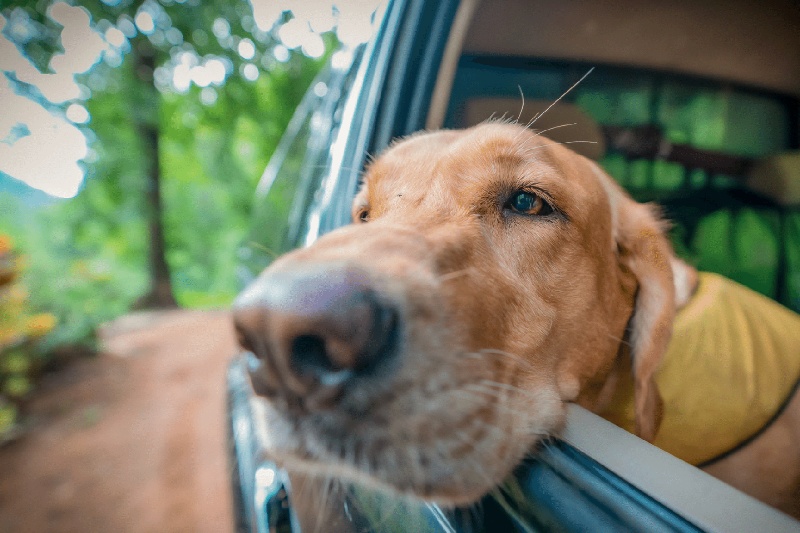Summer is here at last! That means warmer weather, longer evenings, and lots of adventures — and of course, our doggies want to join in the fun!
But as much as we love to bring our pooches along to the beach and picnics in the park, they can often get car sick and it can ruin the buzz a little. After all, no one wants to spend their holidays mopping up puke in the back seat!
Dog car sickness is very common, especially in puppies who aren’t used to cars. Don’t despair, though. If your dog suffers from car sickness, it doesn’t necessarily mean that they have to stay at home.
In this article, we’ll learn how to deal with dog car sickness and make every trip memorable for the right reasons!
What causes dog car sickness?
Dogs get sick in the car for all sorts of reasons. They might be over-excited, scared, or just nauseous from the motion of the car. It is especially common for puppies and young dogs, but they usually grow out of it over time.
Here are a few of the most common reasons your dog might have an upset tummy during car journeys:
Motion sickness
The constant movement of the car can cause the fluid in your dog’s ear to slosh about, causing them to feel dizzy and nauseous. This is especially common in puppies as the parts of the inner ear involved in balance are not fully developed yet, but it can occur in dogs of any age.
Anxiety
If your puppy or young dog isn’t used to the car yet, it’s only natural that they will feel a little anxious. New experiences can be extremely stressful, especially ones that are noisy and involve a lot of movement!
Even if your dog is older, they might still feel anxious about going in the car, especially if they associate it with unpleasant visits to the vet or being left at a boarding kennel.
How will I know if my dog is experiencing car sickness?
Unfortunately, your pooch can’t shout ‘pull over!’ when they feel sick, so you’ll have to be aware of the signs to watch out for.
Every dog is different, but some of the most common symptoms of motion sickness include:
- Listlessness
- Yawning
- Whining and pacing
- Excessive drooling
- Smacking or licking lips
- Lethargy
And of course, the obvious ones: vomiting and diarrhoea. Ideally, it won’t get to this stage, though! Follow the tips in the next section to reduce the likelihood of your pooch experiencing car sickness.
Tips to prevent dog car sickness
Create a positive mental association with the car
Take your puppy on lots of short, fun trips to get them used to the car. If they have a stressful or scary experience when they’re young, then they might associate future car journeys with that traumatic event.
To help with this, you can have a box of special toys and treats that your dog only gets in the car — they will soon learn that it’s something to look forward to!
Take it slow
With some dogs, you might need to build up their tolerance very gradually. Don’t rush the process or you risk creating a negative association. If your puppy or older dog shows signs of stress or anxiety as soon as they get into the car, just sit there for a few moments, give them a treat and let them out again.
Next time, turn the car on and leave it running for 5 minutes or so. Always treat and praise your dog so they start to associate the car with nice things. After a while, you should be able to go for a short drive and continue to build it up from there.
Open windows
Roll the windows down a bit so your dog can sniff the fresh air. All the different smells can help distract them from feeling stressed or sick.
Don’t feed too soon before travel
Dogs can get car sick even on an empty stomach, but it’s less likely (and less messy to clean up if it does happen!) Feed your pup several hours before you leave and make sure they’ve had the opportunity to go to the toilet.
You should also offer them clean drinking water on the journey, as this can help keep nausea at bay.
Allow them to look out the window
Your dog should always be safely restrained while travelling in the car, but you should let them look out the window if possible. This will help them to get oriented with the moving world and reduce the likelihood of motion sickness.
Conclusion
At Mark + Chappell, we care about the welfare of your dog and we want you to be able to enjoy lots of adventures together.
If the steps above don’t work or your dog needs a little bit of extra reassurance, we have a range of products to help with canine anxiety:
Serene-UM Calming Tablets
Serene-UM Calming Drops
Serene-UM Extra Calming Tablets
Don’t let dog car sickness stop you from getting out and about this summer. Check out our blog today for our expert dog advice and make car journeys a calm, stress-free experience for your pooch!






